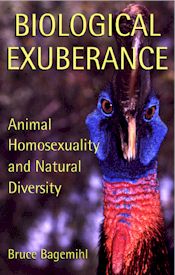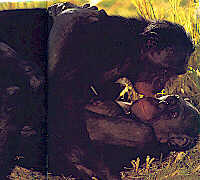 |


|
|
Biological Exuberance Biological Exuberance: Animal Homosexuality and Natural Diversity By Bruce Bagemihl, Ph.D.; St. Martin's Press; 752 pages; $40.00 (hardback edition; paperback edition forthcoming).  The most important book on homosexuality published in 1999 was not about
gay men or lesbian women but about what we humans smugly call the
"lesser species".
The most important book on homosexuality published in 1999 was not about
gay men or lesbian women but about what we humans smugly call the
"lesser species".
Time magazine, which does not generally cover gay or scholarly books, devoted a full page to Biological Exuberance; the first comprehensive study of homosexual and other "nonreproductive" behavior among animals. If nothing else, Bruce Bagemihl's massive study rebuts the argument that homosexuality is "unnatural" because "animals do not indulge in it." On the contrary, Bagemihl argues, "On every continent, animals of the same sex seek each other out and have probably been doing it for millions of years. They court each other, using intricate and beautiful mating dances that are the result of eons of evolution. Males caress and kiss each other, showing tenderness and affection toward one another rather than just hostility and aggression. Females form long-lasting pair-bonds - or maybe just meet briefly for sex, rolling in passionate embraces or mounting one another. Animals of the same sex build nests and homes together, and many homosexual pairs raise young without members of the opposite sex. Other animals regularly have partners of both sexes, and some even live in communal groups where sexual activity is common among all members, male and female.
Of course the idea that "the animal kingdom is ... not just heterosexual" is one that heterosexist scientists have tried their to rebut. Sometimes scientists forcibly separated same-sex animal couples "for their own good". More often, they tried to rationalize same-sex animal behavior as "aggression", "competition" or "confusion". Never mind that "Homosexual behavior occurs in more than 450 different kinds of animals worldwide, and is found in every major geographic region and every major animal group." Homophobia, on the other hand, is an uniquely human behavior. Biological Exuberance is divided into two sections. The first, duller but actually more important section, "A Polysexual, Polygendered World", is an in-depth study of "nonreproductive" animal behavior, divided into "five major behavioral categories: courtship, affection, sex, pair-bonding, and parenting." Part 2, "A Wondrous Bestiary", profiles mammals and birds who exhibited homosexual, bisexual or transsexual behavior. Only the most dedicated reader would dare read Biological Exuberance in its 700-plus page entirety.
Bagemihl calls his "new paradigm" "Biological Exuberance", hence the title of the book: "The essence of Biological Exuberance is that the natural systems are driven as much by abundance and excess as they are by limitation and practicality. Seen in this light, homosexuality and nonreproductive heterosexuality are 'expected' occurrences-- they are one manifestation of an overall 'extravagance' of biological systems that has many other expressions." I suspect that Dr. Bagemihl got carried away--biologically exuberant-- with his facts, and went out on a theoretical limb trying to come up with a "new paradigm." Though Bagemihl rightly accuses other scientists of "projecting human qualities onto animals," he himself does it quite too often. Nature works in mysterious ways, and scientists should be careful about projecting their values--or their political agendas--onto other species. All this does not detract from the importance of Biological Exuberance, both as as a scientific text and as a contributor to the field of lesbian and gay studies. Though it is too soon to gauge the book's influence and impact (which is why I left it out of my list of the Top 100 Books of the 20th Century), I predict that it will soon take its place besides such landmark tomes as Sexual Behavior in the Human Male (1948) and Sexual Behavior in the Human Female (1955). Like the Kinsey Reports, Biological Exuberance is read by a few but discussed by many, among the mainstream as well as within the queer and scientific communities. It is safe to say that no other GLBT book published in 1999 will match that accomplishment. sx |
 © 1997-99 BEI
© 1997-99 BEI
 Two Bonobo females enjoy the company of one another
Two Bonobo females enjoy the company of one another